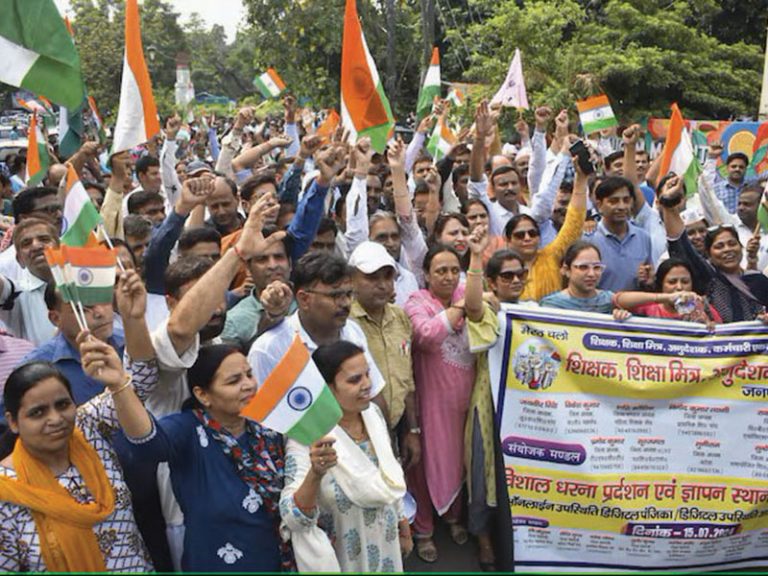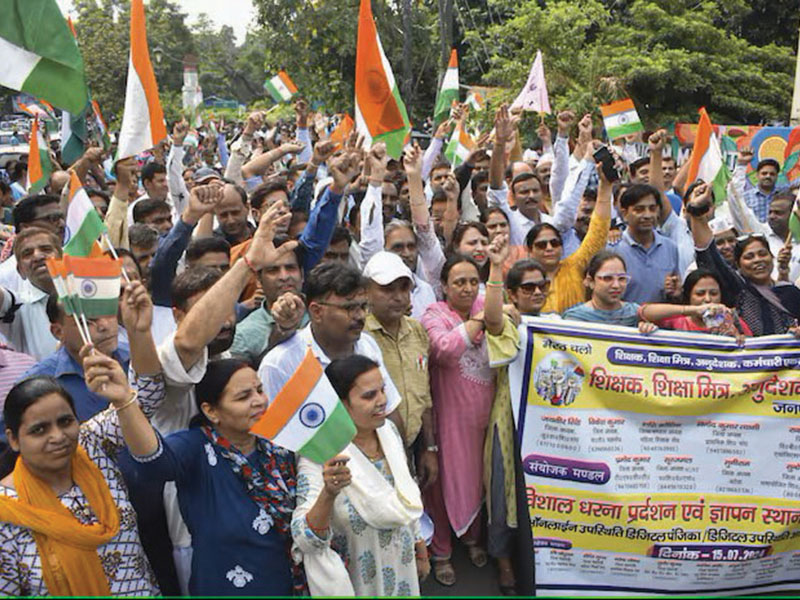No products in the cart.
Uttar Pradesh: Teacher power
Vidya Pandit (Lucknow)
A July 8 order issued by Uttar Pradesh’s BJP government which directed government school teachers to mark their attendance digitally — proclaimed as a first countrywide — was rescinded on July 16 after statewide protests by the teachers community.
Political commentators in Lucknow, the admin capital of India’s most populous state (215 million), are unanimous that revocation of the July 8 order signals a major climb down by the state’s BJP government and acknowledgement of the political power of the teachers’ community. With by-elections for ten legislative assembly seats due to be held later this year, the BJP government headed by Hindu monk-turned-saffron robes-clad chief minister Yogi Adityanath has chosen the path of discretion over confrontation. Especially after the state BJP performed poorly in General Election 2024 when it won only 33 Lok Sabha seats — 29 fewer than in General Election 2019. Evidently, the BJP leadership in Lucknow has decided not to antagonise the 6.28 lakh-strong government teachers’ community on the eve of the important assembly bye-elections.
UP’s government school teachers represented by the Uttar Pradesh Shikshak Sangh union objected to the daily digital attendance register on several grounds. One, that the privacy of teachers, especially women, could be breached as there was no saying how the selfies they would take to upload for attendance would be used. Secondly, that it was an “affront to teachers’ dignity” to suggest that teachers’ late-coming and truancy is widespread and thirdly, “technical glitches” could prevent them from registering attendance on time. Moreover, the union says teachers are often late because of issues beyond their control, such as bad roads and public transport shortages.
The quick cave-in of the state’s BJP government to the teachers’ agitation has disappointed objective educators because it’s well-known that government primary-secondary school teachers in north India — especially Uttar Pradesh and Bihar — are highly indisciplined and responsible for the rock-bottom learning outcomes of children in UP’s government schools.
According to the Annual Status of Education Report (ASER) of the Pratham Education Foundation, 29.2 percent of 1,531 teens from 1,203 households in 60 villages in UP’s representative Hathras district can’t read class II level textbooks in any language and 54.3 percent can’t manage basic division sums. That an estimated 40-50 percent of highly paid (relative to private schools) government school teachers are absent every day is a related statistic.
“Teachers with security of employment, salary and perks have a substantial say in the education system. Parents and their committees that check teaching and mid-day meals, among other things, also have a stake in the system. The only people who have no say in education is children. They cannot demand that they are taught and taught well. That is the tragedy of school education in UP and countrywide,” says Sarvendra Vikram Singh, former director of basic education.
However Rajendra Prasad Mishra, vice president and spokesperson of the Uttar Pradesh Madhamik Shikshak Sangh (secondary teachers association), which has membership of 52,000 teachers from government aided secondary schools, is of the opinion that the government’s digital attendance marking order was an over-kill. “Errant teachers account for just one percent of the total. If the administration carries out proper audit of schools, these teachers can be identified and isolated. It is because officers of the education department don’t perform their duties that teachers are being targeted,” he says.
Inevitably, this issue has become politicised. Former chief minister Akhilesh Yadav took to social media to demand that an online attendance system should first be introduced in government administrative offices. “No teacher wants to be late,” said Yadav, attributing teachers late-coming to factors such as inefficient public transport and long commuting hours.
Looks like in UP’s 132,855 government schools, it will be business as usual.
















Add comment